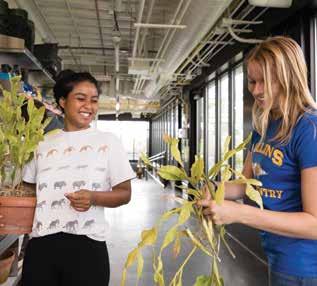
2 minute read
Greenhouse Gains
Rollins’ new rooftop greenhouse is a technological masterpiece, with more than 800 plant species and climatecontrolled rooms designed for student and faculty research.
Perched atop the Bush Science Center like an airy, steel-beamed architectural marvel from a bygone world’s fair, Rollins’ new rooftop greenhouse is a splendid sight to behold. But exterior beauty only tells half the story.
Step inside this fully automated, climatecontrolled environment and you’ll find a botanical wonderland of 800-plus plant species—from orchids and herbs to the famously odd corpse plant that just a few years ago landed Rollins a spot in Ripley’s Believe It or Not.
Completed in September, the rooftop greenhouse is a marked upgrade from its onground predecessor built in 1983 on the shores of Lake Virginia. Now students and professors just have to walk down the hall to gather their objects of inquiry for lessons spanning everything from mitosis to photosynthesis.
“Having the greenhouse as part of the Bush Science Center really complements our educational goals,” says Paul Stephenson, associate professor of biology. “It’s a great step forward for the biology department, and we’re thrilled to have it.”
Featuring four distinct areas—the headhouse, teaching collection room, faculty research room, and student research room—as well as state-of-theart technology and reverse osmosis water filtration, the rooftop greenhouse is literally taking science at Rollins to the next level. The third floor, to be exact.
“They went top of the line here,” says Alan Chryst ’93, Rollins’ greenhouse manager since 1998. “It’s a wonderful utilization of space, a true extension of the labs.”
Home Base
A seemingly ordinary, plantfree room, the headhouse is actually of great importance, providing access to electricity, sinks, storage, and counter space for pot washing, repotting, and general maintenance. It’s also the office of work-study student Lia Potter ’22, an environmental studies major. “Working here is like being in a tropical rainforest,” she says.

A Living Education
Akin to a library, the teaching collection room is where most of the plants live. The structure’s largest room, it includes nine tables on rolling tracks, not to mention myriad rafters for hanging. “We have plants from all over the world,” says Chryst, “because you never know what the students and faculty are going to ask for.”
Learning by Doing
Similar in function to its faculty counterpart, the student research room can be customized for the needs of individual students or entire classes. Due to the pandemic, it has yet to be used to its full capabilities, but that will change come fall. Currently, the room houses xeric plants, like cacti, found in dry conditions.
Real Research

In the faculty research room, professors conduct their own research on four tables that can be adjusted for mist and irrigation. When we visited this past winter, the room held plants that thrive in shade and humidity, including carnivorous varieties, mangroves, a Central American cacao plant, and a coffee tree native to Ethiopia.
Smart Seeds
Think of your Nest hub at home, only on steroids. With a wall-mounted, touch-screen interface and remote functionality, the Seed climate-control system manages every possible growth variable. In addition to controlling heat, humidity, lighting, irrigation, and mist for each room, it also powers large retractable shade cloths.










